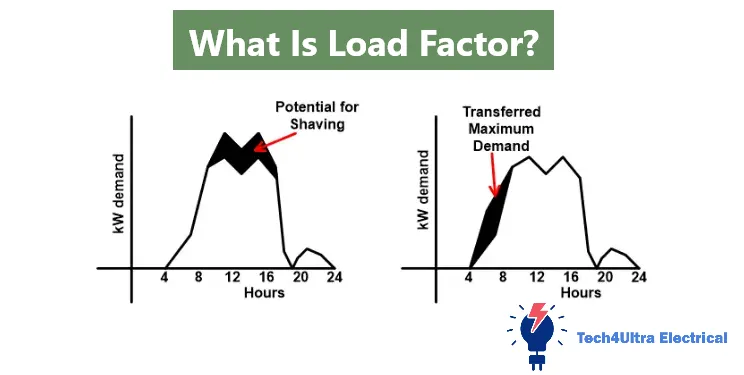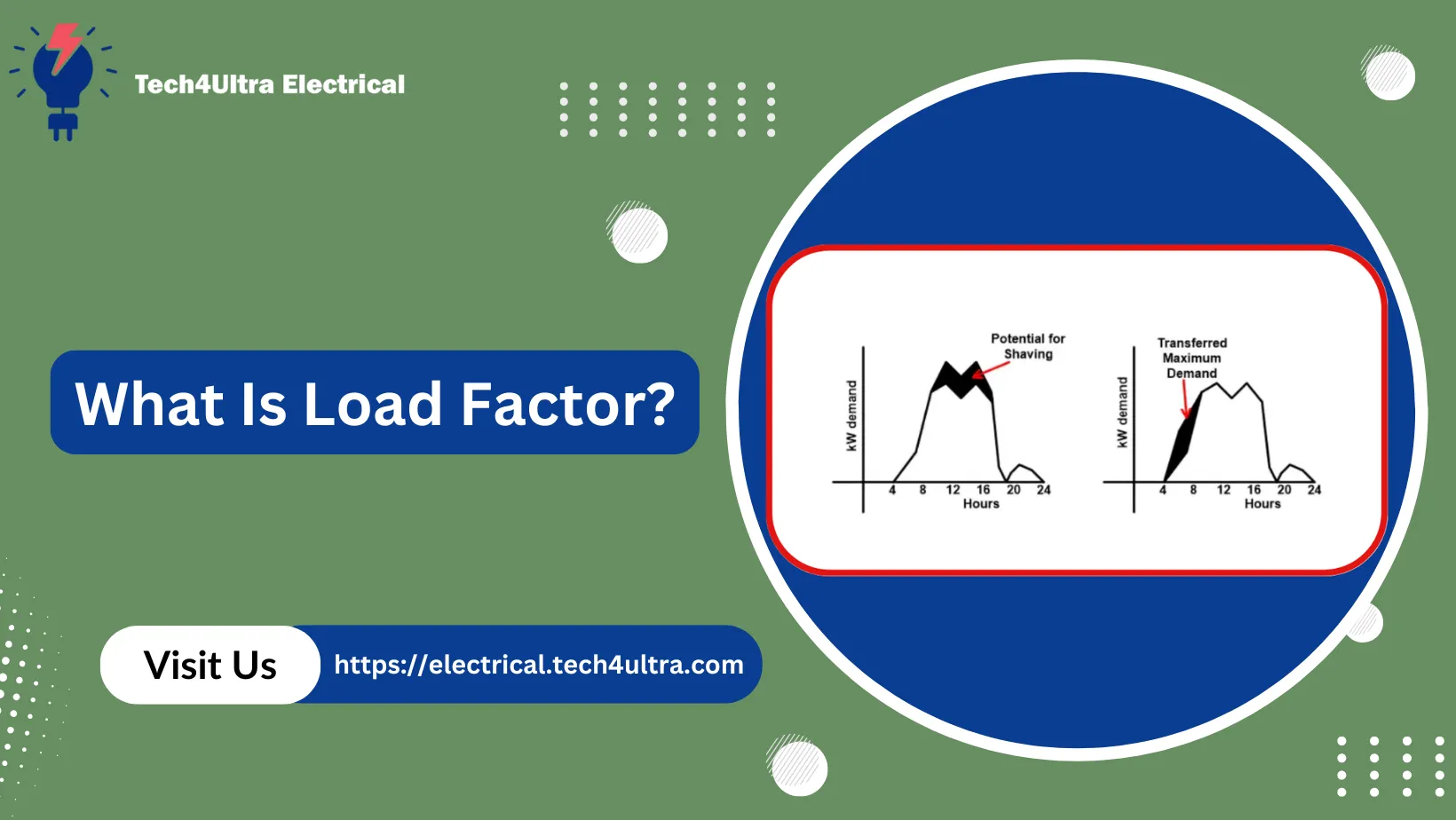Contents
What if I told you that accurately calculating your Load Factor could cut your electricity bill by up to 20%? Many believe that only the amount of electricity consumed matters, but the real game-changer lies in understanding the difference between Maximum Load and Average Load. In this article on the Tech4Ultra Electrical website, you’ll learn how these concepts work together and how you can use them to boost efficiency and reduce wasted energy in any industrial or commercial setting. Keep reading to discover how your numbers can turn into serious savings.

What Is Load Factor?
Load Factor is a measure of how efficiently electrical power is being used over a specific period. In simple terms, it’s the ratio of the average load to the maximum load (or peak demand) during a given time frame. It’s expressed as a percentage, and the closer this value is to 100%, the more consistent and efficient your power usage is.
In the context of electrical systems—especially in industrial or commercial settings—Load Factor plays a key role in assessing how effectively electrical resources are utilized. Utilities use it to evaluate demand patterns and price structures, while facility managers rely on it to pinpoint inefficiencies, avoid penalties, and optimize operations.
It’s important not to confuse Load Factor with related terms like Demand Factor and Diversity Factor. Demand Factor is the ratio of the actual maximum demand of a system to the total connected load. It tells you how much of the system’s potential is being used at its peak. On the other hand, Diversity Factor refers to the likelihood that all loads won’t peak at the same time, which helps in sizing transformers and feeders.
In short:
– Load Factor = Average Load ÷ Maximum Load
– Higher Load Factor = More stable and efficient energy use
Understanding this can significantly impact your energy planning and cost control.
Read Also: Electric Power System: Key Parts and How It Works
Load Factor Formula Explained
The standard formula for calculating Load Factor is:
Load Factor = (Average Load × Time Period) ÷ (Maximum Load × Time Period)
Since the time period appears in both the numerator and denominator, it often simplifies to:
Load Factor = Average Load ÷ Maximum Load
Let’s break it down:
- Average Load: This is the average amount of electrical power used over a given billing period. It reflects your normal consumption patterns and is typically measured in kilowatts (kW).
- Maximum Load (or Peak Load): This is the highest level of electrical demand recorded during the same period. It usually happens when multiple high-power devices operate simultaneously.
- Billing Period: This is the time span over which the energy consumption and peak demand are measured—often monthly or yearly. Utilities use this period to calculate charges based on your energy usage and demand profile.
Understanding the formula helps businesses identify usage inefficiencies. A low Load Factor suggests you’re drawing large amounts of power in short bursts, which can lead to higher charges. By balancing loads and flattening peaks, you can improve efficiency and reduce energy costs.
Step-by-Step Guide: How to Calculate Load Factor
Calculating Load Factor is simpler than it seems. Follow these steps to do it accurately and make better energy decisions:
- Determine your billing period: Usually monthly, but it could be daily or yearly depending on your data.
- Find the Maximum Load: This is the peak demand (in kilowatts, kW) your system recorded during the billing period. Check your utility bill or energy monitoring system.
- Calculate the Average Load: Divide the total energy consumed during the billing period (in kilowatt-hours, kWh) by the number of hours in that period. For example, in a 30-day month: 30 × 24 = 720 hours.
Formula: Average Load (kW) = Total kWh ÷ Total Hours - Apply the Load Factor formula:
Load Factor = Average Load ÷ Maximum Load - Convert to percentage: Multiply your result by 100 to express it as a percentage.
Example:
Total consumption = 36,000 kWh
Peak demand = 200 kW
Total hours = 720
Average Load = 36,000 ÷ 720 = 50 kW
Load Factor = 50 ÷ 200 = 0.25 = 25%
Common Units:
- Energy: kilowatt-hours (kWh)
- Load: kilowatts (kW)
Pitfalls to avoid:
- Using inconsistent time periods for load and consumption
- Confusing kW with kWh
- Forgetting to convert the final value into a percentage
Staying consistent with units and time frames is the key to accurate Load Factor calculations.
Watch Also: Sources of Electrical Energy: Types and How They Work
Real-World Examples of Load Factor
Understanding Load Factor becomes easier with real-world cases. Here’s how it plays out across different sectors:
1. Commercial Building
A 10-story office building operates 12 hours a day. It consumes 72,000 kWh in a 30-day month, and its peak demand is 250 kW.
| Metric | Value |
|---|---|
| Total Energy Consumption | 72,000 kWh |
| Billing Period | 30 days = 720 hours |
| Average Load | 72,000 ÷ 720 = 100 kW |
| Maximum Load | 250 kW |
| Load Factor | 100 ÷ 250 = 0.40 = 40% |
Interpretation: A 40% Load Factor indicates uneven power use—potential for cost optimization.
2. Industrial Facility
A small manufacturing plant uses 180,000 kWh monthly with a peak demand of 300 kW.
| Metric | Value |
|---|---|
| Total Energy Consumption | 180,000 kWh |
| Billing Period | 30 days = 720 hours |
| Average Load | 180,000 ÷ 720 = 250 kW |
| Maximum Load | 300 kW |
| Load Factor | 250 ÷ 300 = 0.83 = 83% |
Interpretation: High Load Factor shows efficient and steady power usage—ideal for minimizing demand charges.
3. Residential Usage
A household consumes 1,200 kWh monthly with a peak load of 6 kW.
| Metric | Value |
|---|---|
| Total Energy Consumption | 1,200 kWh |
| Billing Period | 30 days = 720 hours |
| Average Load | 1,200 ÷ 720 ≈ 1.67 kW |
| Maximum Load | 6 kW |
| Load Factor | 1.67 ÷ 6 ≈ 0.28 = 28% |
Interpretation: Low Load Factor due to intermittent usage—typical in homes. Improving it isn’t always practical but can highlight energy spikes.
What Does Load Factor Indicate?
The Load Factor tells you how consistently power is used over time. A high Load Factor (closer to 100%) means your energy usage is steady and well-distributed, while a low Load Factor indicates occasional power spikes and idle periods.
High Load Factor:
- Efficient use of energy infrastructure
- Lower per-unit electricity cost due to spread-out demand
- Fewer penalties from utility providers
Low Load Factor:
- Indicates erratic or peaky power usage
- Higher demand charges from utility companies
- Potential underutilization of electrical systems
Operational Implications: Facilities with high Load Factors often run equipment continuously or in well-planned schedules, reducing sudden surges. This smooth load profile improves equipment lifespan and reduces maintenance issues.
Energy Cost Considerations: Utilities often apply higher charges for demand peaks. By maintaining a high Load Factor, you can avoid those spikes, reduce your demand charges, and ultimately lower your overall energy bills. It’s a critical KPI for energy managers aiming to optimize both performance and costs.
Why Load Factor Matters for Energy Efficiency
A strong Load Factor isn’t just a technical metric—it’s a direct path to saving money and improving your energy footprint. The more consistent your average load is compared to your maximum load, the better your energy efficiency.
Cost Savings: A higher Load Factor spreads energy usage more evenly, helping avoid steep maximum load peaks. Since utilities often charge for both energy (kWh) and demand (kW), keeping your demand low relative to usage reduces your bill significantly. Facilities that maintain steady operations tend to benefit the most.
Utility Billing: Many electricity providers apply a demand charge based on your peak usage. Even a short spike can increase your bill for the entire month. A low Load Factor often results in paying for capacity you rarely use. Optimizing operations to increase your Load Factor can reduce or eliminate these extra charges.
Environmental Impact: A high Load Factor means less strain on the grid and more efficient generation. This helps reduce the need for standby generation plants—often fossil-fueled—which cuts down carbon emissions. Improving Load Factor contributes not just to cost savings, but also to a cleaner, more sustainable energy system.
Tips to Improve Load Factor
Improving your Load Factor starts with understanding when and how your energy is being consumed. The goal is to make your average load more consistent and reduce your maximum load peaks. Here’s how:
1. Peak Shaving Techniques
- Shift usage: Move non-essential or flexible operations to off-peak hours.
- Battery storage: Store energy during low-demand periods and use it during peak times.
- Demand response: Partner with your utility to reduce load during peak periods in exchange for billing credits.
2. Load Balancing Strategies
- Stagger equipment starts: Avoid starting multiple heavy-load devices simultaneously.
- Schedule production runs: Spread high-energy tasks throughout the day to avoid clustering loads.
- Use timers and load controllers: Automate device usage to maintain a more even demand profile.
3. Equipment and Automation
- Install energy-efficient motors: They reduce demand and improve operational efficiency.
- Use Variable Frequency Drives (VFDs): These allow motors to run at optimized speeds based on need.
- Energy management systems (EMS): Monitor and control loads in real time to avoid spikes.
Improving Load Factor requires planning, the right tools, and consistency. Even small changes in operational habits and equipment control can lead to noticeable cost reductions and better energy performance over time.
Watch Also: Rise Time: Definition, Formula, and Practical Examples
Comparative Concepts: Load Factor vs Capacity Factor
Load Factor and Capacity Factor are often confused, but they refer to different things.
Load Factor measures how efficiently a system uses its electrical demand over a period. It’s the ratio of average load to maximum load.
Capacity Factor, on the other hand, is used in power generation. It measures how much energy a power plant actually produces over time compared to its maximum possible output.
Use Load Factor when analyzing energy usage patterns in a facility—commercial, industrial, or residential. It helps in energy billing and operational efficiency.
Use Capacity Factor when evaluating power generation performance—such as for solar, wind, or thermal plants. It shows how fully the generation capacity is being utilized.
In short, Load Factor is for energy consumers; Capacity Factor is for energy producers.
Conclusion
Understanding your Load Factor is key to managing energy usage efficiently and cutting unnecessary costs. By comparing your average load to your maximum load, you get a clear picture of how effectively you’re using electricity over time.
A high Load Factor means stability and savings, while a low one often signals inefficiencies that can be improved. Whether you’re running a commercial office, a manufacturing plant, or a residential building, optimizing your load profile can lead to better financial and environmental outcomes.
Final tip: Regularly track your Load Factor using utility data, smart meters, or energy management tools. Look for patterns, identify peaks, and consider strategies like load shifting or upgrading to more efficient equipment.
By staying proactive, you’ll gain control over your energy footprint, reduce operational costs, and make smarter, data-driven decisions for the future.
FAQs
What is a good Load Factor?
A good Load Factor generally falls between 70% and 90%. This range indicates that a facility is using its power supply efficiently and evenly throughout the billing period. A Load Factor closer to 100% means you’re consuming power in a consistent, predictable way, which helps reduce utility costs. In contrast, values below 50% suggest high peaks and idle times—signs of inefficient usage patterns that can result in higher demand charges.
How do utilities use Load Factor?
Utilities monitor Load Factor to assess the demand stability of their customers. A low Load Factor alerts them that a customer may be drawing high peak loads without consistent usage, which places more stress on the grid. As a result, utilities may apply demand charges to recover infrastructure costs. Some even offer incentive programs for customers with consistently high Load Factors to encourage more stable power usage.
How can businesses monitor Load Factor?
Businesses can track their Load Factor using energy monitoring tools and utility data. Here’s how:
- Smart meters: Many utilities now provide detailed usage reports through smart metering systems.
- Energy management systems (EMS): These platforms analyze consumption and demand trends in real-time and offer alerts for peak usage.
- Utility bills: Your bill typically lists peak demand (kW) and total consumption (kWh)—use this to calculate the Load Factor manually or with a spreadsheet.
Regular monitoring helps identify opportunities for improvement and informs decisions about scheduling, equipment use, and energy investments. Over time, tracking Load Factor can lead to cost savings and a more efficient electrical system.
How is the Load Factor calculated?
The Load Factor is calculated by dividing the Average Load by the Maximum Load during a billing period. The formula is:
Load Factor = (Total Energy Used in kWh ÷ Total Hours) ÷ Maximum Load in kW
You can also express it as a percentage by multiplying the result by 100.
What is a 70% Load Factor?
A 70% Load Factor means that, on average, the facility used 70% of its peak demand consistently throughout the billing period. This is generally considered efficient and stable usage. It implies well-balanced operations and fewer spikes, leading to lower demand charges and better energy cost control.
How is load calculation calculated?
Load calculation refers to estimating the total electrical demand of a system. It involves summing the power requirements (in watts or kilowatts) of all devices and systems in use, often with adjustment factors like Diversity Factor and Demand Factor. For buildings, engineers typically use methods from standards like NEC or ASHRAE to calculate HVAC and lighting loads accurately.
What is a 60% Load Factor?
A 60% Load Factor indicates moderate efficiency. It means the facility used an average of 60% of its peak capacity over the billing cycle. While not poor, it suggests there may be room to smooth operations, reduce peak demand, and save on utility bills through techniques like load shifting or automation.
Is 80% Load Factor good?
Yes, an 80% Load Factor is considered very efficient. It means you’re using 80% of your peak electrical capacity consistently, reducing demand charges and optimizing operational costs. Many industrial and commercial facilities aim for Load Factors above 75% for cost-effectiveness.
What is the Load Factor ‘n’ formula?
In hash tables, the Load Factor (n) is calculated using a different context than electrical systems. It’s the ratio of the number of stored elements to the total number of available slots:
Load Factor (n) = Number of Elements ÷ Number of Buckets
This helps in understanding the density of the hash table and when to resize.
Can Load Factor be greater than 1 in a hash table?
Yes, in hash tables, the Load Factor can exceed 1 if you’re storing more elements than there are buckets. While this is allowed, it typically leads to performance issues, like more collisions, and may trigger rehashing to maintain efficiency.
What is a normal Load Factor?
A normal Load Factor depends on the context. For power systems, 70% to 90% is ideal. For hash tables, a typical Load Factor is around 0.75 before triggering resizing. In either case, it’s a measure of how fully capacity is utilized.
What is the formula to find the load?
The formula to calculate electrical load (in watts) is:
Load (W) = Voltage (V) × Current (A)
For example, a device using 10 amps at 230 volts would have a load of 2,300 watts. This is useful for sizing systems and calculating total power demand.
How to calculate AC load?
To calculate AC load, use the formula:
Load (W) = Voltage (V) × Current (A) × Power Factor (PF)
This gives you the real power consumed. Make sure to use RMS values and a power factor between 0 and 1 (usually 0.8 for many appliances).
How to calculate Power Factor?
Power Factor (PF) is calculated as:
PF = Real Power (kW) ÷ Apparent Power (kVA)
A PF of 1 means all the power is being effectively used, while a lower PF indicates inefficiency and potential extra charges from utilities.
What is the formula for Load Factor in structural analysis?
In structural engineering, Load Factor is part of the Load and Resistance Factor Design (LRFD) method. It’s calculated as:
Load Factor = Design Load ÷ Nominal Load
It accounts for uncertainty in loading conditions and ensures safety margins in structural design.
What is an example of a Load Factor?
In a power plant consuming 200,000 kWh in a month with a peak load of 500 kW:
Average Load = 200,000 ÷ 720 = 278 kW
Load Factor = 278 ÷ 500 = 0.556 = 55.6%
This means the plant used 55.6% of its peak capacity on average—room for efficiency improvement.
What is the Load Factor method?
The Load Factor Method is used in both electrical systems and structural engineering to estimate demand or design strength. In energy, it assesses usage efficiency. In structures, it adjusts load estimates to include safety margins using specific multipliers for dead and live loads.
How to calculate Load Factor in data structure?
In data structures, especially hash tables, Load Factor is:
Load Factor = Number of Entries ÷ Number of Buckets
This helps determine when to resize the hash table to maintain performance. A common threshold is 0.75.

